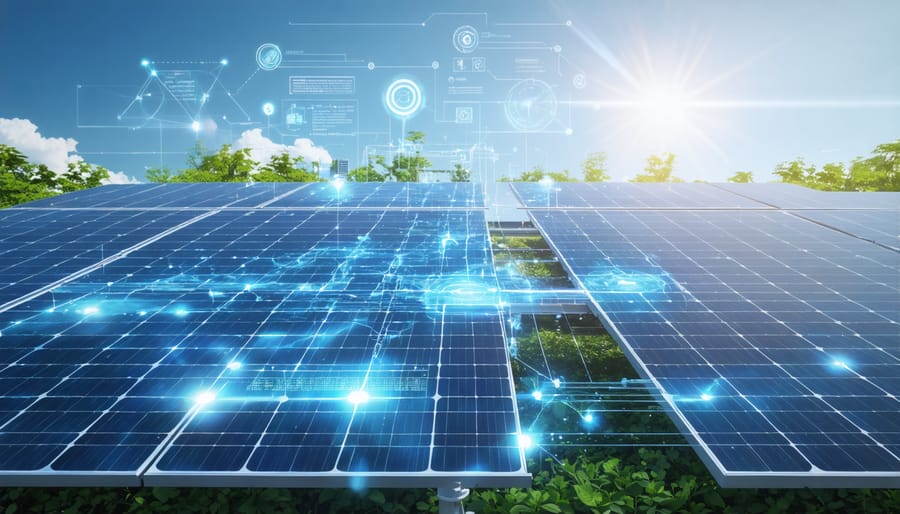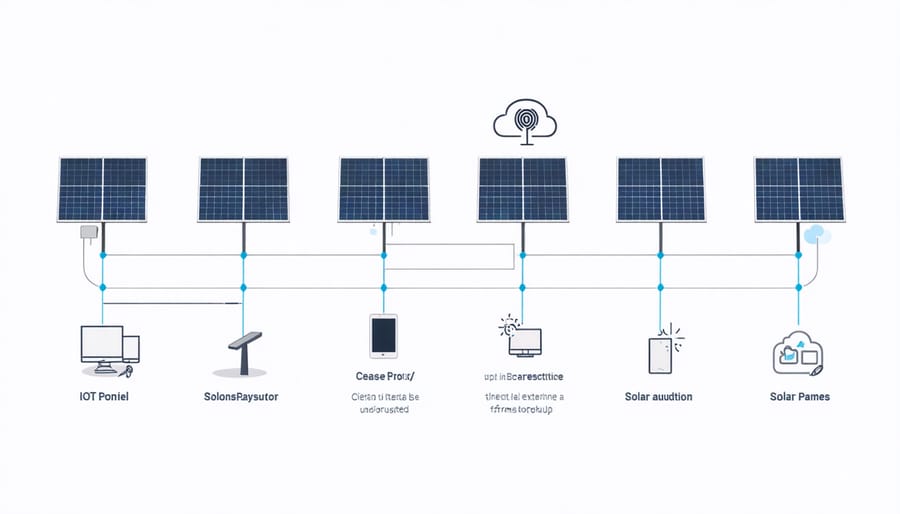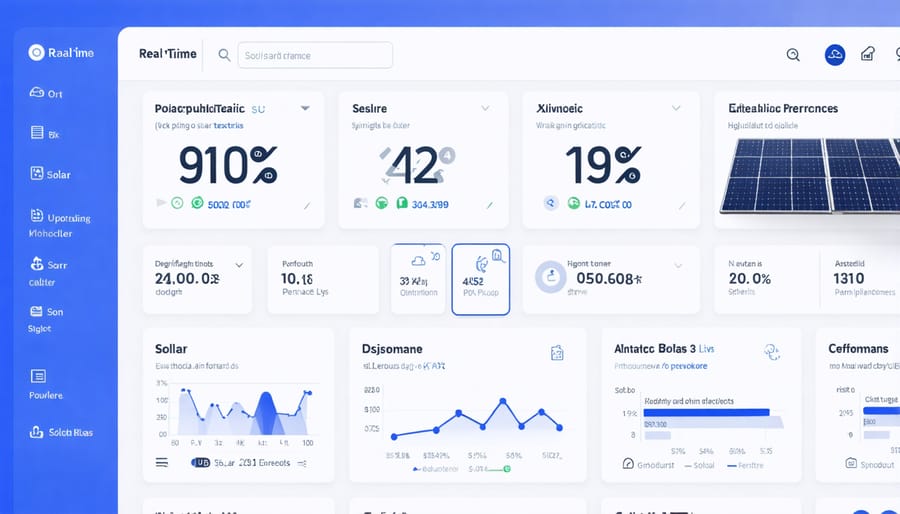IoT Solar Monitoring: How Smart Sensors Transform Your Solar Performance

Energy IoT is revolutionizing how we monitor, manage, and optimize power consumption across homes, businesses, and industrial facilities. By connecting smart meters, sensors, and energy-generating assets through intelligent networks, Energy IoT creates a dynamic ecosystem that transforms passive power systems into responsive, data-driven infrastructures.
Modern energy management demands real-time insights and automated decision-making capabilities that traditional systems simply cannot deliver. Through the integration of IoT devices, facility managers and homeowners can now track energy usage patterns, identify inefficiencies, and implement automated responses to fluctuating demand—all while reducing operational costs and environmental impact.
The convergence of renewable energy sources, particularly solar installations, with IoT technology has created unprecedented opportunities for optimization. Smart sensors continuously monitor performance metrics, weather conditions, and grid demands, enabling systems to automatically adjust their operations for maximum efficiency. This intelligent orchestration of energy resources not only enhances system reliability but also accelerates Europe’s transition toward a more sustainable energy future.
As we embrace this digital transformation in energy management, organizations that adopt Energy IoT solutions position themselves at the forefront of innovation, prepared to meet evolving regulatory requirements while achieving significant cost savings and sustainability goals.
Smart Sensors: The Building Blocks of Solar IoT

Essential Solar IoT Sensors
Modern solar installations rely on a sophisticated network of IoT sensors to monitor and optimize performance. These essential sensors work together to provide real-time data and insights across various solar parameters.
Irradiance sensors measure the amount of solar energy reaching your panels, helping predict energy generation potential and identify optimal operating conditions. Temperature sensors monitor both ambient conditions and panel surface temperatures, crucial for maintaining efficiency as solar panels perform best within specific temperature ranges.
Current and voltage sensors track electrical output throughout the system, from individual panels to the complete array. These measurements are vital for detecting performance issues and ensuring optimal power conversion. Weather stations, incorporating humidity, wind speed, and precipitation sensors, provide environmental context that affects solar generation.
Panel position sensors work with tracking systems to ensure optimal alignment with the sun, while dust and soiling sensors alert owners when panels need cleaning to maintain peak efficiency. Smart inverter sensors monitor power conversion effectiveness and grid interaction, essential for both residential and commercial installations.
For comprehensive system health monitoring, string monitoring sensors detect issues at the panel group level, while micro-inverter sensors provide detailed performance data for individual panels. This granular monitoring enables predictive maintenance and swift problem resolution, maximizing the return on solar investments.
European solar installations particularly benefit from these sensor networks, as they help optimize performance despite varying seasonal conditions and regional weather patterns.
Real-Time Data Collection
Modern IoT sensors form the backbone of intelligent energy monitoring systems, continuously gathering crucial performance data from various components of solar installations. These sophisticated devices measure everything from power output and voltage levels to environmental conditions like temperature and irradiance. The collected data is transmitted through secure wireless networks, enabling real-time solar analytics that help optimise system performance.
The data collection process typically involves multiple sensor types working in harmony. Power optimisers attached to individual panels track micro-level performance, while smart inverters monitor overall system efficiency. Weather stations integrated into the setup provide contextual environmental data, creating a comprehensive picture of operating conditions.
These sensors communicate through various protocols, including Wi-Fi, cellular networks, or dedicated low-power wide-area networks (LPWAN), ensuring reliable data transmission even in challenging conditions. The information is encrypted and sent to secure cloud servers, where it’s processed and analysed to generate actionable insights.
The frequency of data collection can be adjusted based on specific monitoring needs, ranging from second-by-second updates for critical industrial applications to hourly summaries for residential systems. This flexibility ensures that energy consumption patterns are accurately captured while maintaining system efficiency and network bandwidth optimization.
Maximizing Solar Performance Through IoT Integration
Predictive Maintenance
In the realm of energy management, predictive maintenance systems have revolutionized how we monitor and maintain solar installations and energy infrastructure. By leveraging IoT sensors and sophisticated algorithms, these systems continuously analyse equipment performance, detecting subtle changes that might indicate potential issues before they escalate into costly failures.
Smart sensors monitor critical parameters such as inverter efficiency, panel temperature, and power output fluctuations in real-time. This constant surveillance allows facility managers and homeowners to identify maintenance needs with unprecedented accuracy. Instead of relying on fixed maintenance schedules, which might lead to unnecessary interventions or missed problems, IoT-enabled monitoring adapts maintenance timing to actual system conditions.
The benefits are substantial: reduced downtime, extended equipment lifespan, and optimized maintenance costs. For instance, when a solar panel’s performance begins to decline due to dust accumulation or developing micro-cracks, the system alerts operators before significant energy losses occur. Similarly, inverter malfunctions can be predicted days or even weeks in advance, allowing for planned interventions that minimize disruption to power generation.
This proactive approach is particularly valuable in European markets, where weather conditions can vary dramatically and affect solar system performance. The IoT sensors can correlate environmental data with performance metrics, helping distinguish between normal weather-related variations and genuine equipment issues. This intelligence enables maintenance teams to focus their efforts where they’re truly needed, improving both efficiency and cost-effectiveness.
Performance Optimization
IoT-enabled energy systems are revolutionizing how we optimize solar installations through intelligent data analysis and automated adjustments. By continuously monitoring performance metrics, IoT devices help identify inefficiencies and maximize energy yield across the entire system.
Real-time data collection enables swift detection of performance issues, from minor drops in output to potential equipment malfunctions. Smart algorithms analyze weather patterns, historical performance data, and current operating conditions to make predictive adjustments that enhance system efficiency. These solar panel efficiency improvements can lead to significant increases in energy production, often boosting yields by 15-25% compared to non-optimized systems.
The optimization process encompasses multiple aspects:
• Panel orientation adjustments based on sun tracking
• Inverter performance fine-tuning
• Load balancing across system components
• Predictive maintenance scheduling
• Energy storage optimization
Advanced IoT systems can also integrate with smart home devices and building management systems, creating a comprehensive energy optimization network. This integration enables automated responses to energy demand changes, weather conditions, and grid requirements, ensuring optimal system performance under varying conditions.
For European installations, IoT optimization takes into account regional factors such as seasonal variations in daylight hours, local weather patterns, and grid requirements. This localized approach ensures that each system operates at peak efficiency within its specific environmental context, maximizing return on investment while contributing to broader sustainability goals.

Smart Energy Management for European Homes
Energy Consumption Analysis
IoT technology revolutionizes how homeowners interact with and understand their energy consumption patterns. Through a network of smart sensors and connected devices, IoT systems continuously collect real-time data about electricity usage across different appliances and areas of the home. This granular insight enables households to make informed decisions about their energy consumption.
Modern IoT energy monitoring systems present data through user-friendly dashboards, allowing homeowners to track their energy usage patterns hourly, daily, or monthly. These platforms often include features like appliance-specific consumption breakdowns, peak usage alerts, and customizable energy-saving recommendations.
The system might, for instance, detect that your washing machine consumes more energy than similar models, suggesting an upgrade could lead to significant savings. Or it might identify that your heating system runs unnecessarily during certain hours, prompting adjustments to your programming schedule.
Many European households have reported 15-30% reductions in energy costs after implementing IoT-based monitoring solutions. The technology proves particularly valuable when combined with solar installations, as it helps optimize energy consumption around peak solar production hours.
Advanced systems can even automate energy usage by integrating with smart home devices. For example, they can automatically adjust thermostats, switch off standby appliances during peak tariff periods, or schedule energy-intensive activities during optimal solar production times, maximizing self-consumption and reducing grid dependency.

Smart Grid Integration
The integration of home solar systems with modern power infrastructure represents a significant advancement in renewable energy management. Through smart grid integration, households can actively participate in the broader energy ecosystem, enabling bidirectional power flow and real-time communication between consumers and utilities.
This interconnected system allows solar-powered homes to contribute excess energy to the grid during peak production hours and draw power when needed. Advanced IoT sensors and smart meters facilitate this exchange, continuously monitoring energy flow, consumption patterns, and grid stability. The system automatically adjusts to maintain optimal performance and balance across the network.
For European homeowners, this integration offers numerous advantages. During surplus production, excess solar energy can be sold back to the grid, providing additional revenue streams. The smart system also enables dynamic pricing benefits, allowing households to consume grid power when rates are lowest and contribute energy when demand and prices peak.
Furthermore, this intelligent network enhances grid reliability through automated load balancing and predictive maintenance. IoT devices monitor weather patterns, energy consumption trends, and equipment performance, enabling the system to anticipate and respond to changing conditions proactively. This results in improved energy efficiency, reduced power outages, and a more sustainable energy infrastructure for communities across Europe.
Implementation and Support
System Setup
Setting up an energy IoT system begins with a comprehensive site assessment to determine optimal sensor placement and network requirements. Start by installing the primary gateway device in a central location with stable internet connectivity and power supply. This hub will serve as the central communication point for all your energy monitoring devices.
Next, deploy smart meters and sensors at key monitoring points throughout your system. For solar installations, place power meters at the inverter output and main distribution board. Install environmental sensors to track temperature, irradiance, and weather conditions that affect energy production.
Configure your network security settings by establishing a dedicated, encrypted connection for your IoT devices. Most modern systems use Wi-Fi or cellular networks, with backup options for redundancy. Create unique credentials for each device and enable two-factor authentication where available.
Install the monitoring software on your preferred device and connect it to the gateway. Follow the manufacturer’s setup wizard to integrate all sensors into the system. Configure alert thresholds and reporting parameters based on your monitoring needs.
Finally, validate the system by checking real-time data streams from all sensors. Ensure all devices are communicating properly and calibrate sensors if necessary. Schedule regular maintenance checks to maintain system accuracy and reliability.
For optimal performance, consider working with certified installers who understand local regulations and can provide ongoing technical support.
Ongoing Support
Successful implementation of Energy IoT systems requires robust ongoing support to ensure optimal performance and longevity. Most European providers offer comprehensive maintenance packages that include 24/7 system monitoring, regular software updates, and preventive maintenance schedules. These services help identify and resolve potential issues before they impact system performance.
Technical support typically operates through multiple channels, including dedicated helpdesks, remote diagnostics, and on-site assistance when necessary. Many providers offer mobile apps and web portals where users can access real-time support, view system status, and request technical assistance. This multi-channel approach ensures quick response times and efficient problem resolution.
Regular system health checks and performance optimization services are essential components of ongoing support. These include periodic calibration of sensors, verification of data accuracy, and updates to algorithms that manage energy flow. Support teams also help users understand their system’s analytics and provide guidance on optimizing energy consumption patterns.
Training and education form another crucial aspect of ongoing support. Providers regularly organize workshops and webinars to help users maximize their system’s potential. Documentation and user guides are continuously updated to reflect new features and improvements, ensuring users can independently handle routine operations and basic troubleshooting.
For enterprise customers, dedicated account managers often provide personalized support and regular performance reviews, helping organizations achieve their sustainability goals while maintaining system efficiency.
IoT technology has revolutionized solar energy monitoring, offering unprecedented control and visibility over solar installations across Europe. By connecting solar arrays to intelligent monitoring systems, businesses and homeowners can now optimize their energy production, reduce maintenance costs, and maximize their return on investment. The future of solar monitoring looks particularly promising, with emerging technologies like AI and machine learning set to further enhance system capabilities. As Europe continues its transition towards renewable energy, IoT solutions will play an increasingly crucial role in making solar installations more efficient and reliable. The integration of IoT in solar monitoring not only supports sustainability goals but also empowers users with data-driven insights for better energy management. As these technologies become more accessible and sophisticated, we can expect to see wider adoption across residential and commercial sectors, ultimately contributing to a more sustainable and energy-efficient future.
Leave a Reply